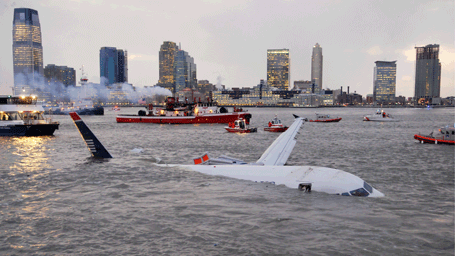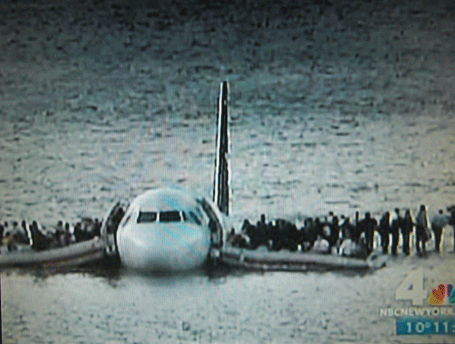
By Rev. Dr. Frank Marangos
“It is a Miracle!” This is the way that media pundits, politicians and most Americans first characterized the airline crash that occurred on a cold January afternoon in Manhattan. News reports of the incident, complete with amateur photographs, video and eyewitness accounts filled television, Internet, and radio airwaves. According to the government’s official report, US Airways flight 1549 lost power after liftoff from LaGuardia Airport when a flock of geese flew into its engines. The pilot, Sully Sullenberger, amazingly glided the airplane over the George Washington Bridge and safely ditched it into the Hudson River. All of the 155 passengers and crew were safely rescued from the plane before it slowly began to sink into the frigid waters. Underscoring the unprecedented nature of the remarkable landing, the copilot turned to Sullenberger and remarked, “You know Sully, no one has ever had a successful ditch like this before . . . you pulled it off!” The photograph of the floating plane with its passengers standing on its wings was published on the top front folds of newspapers and magazines throughout the globe with the caption: “Miracle on the Hudson!”
Sadly, yet not surprisingly, it was not long for the story’s punctuation to change from explanation point to that of question mark. As the novelty of the extraordinary event began to wane, airplane manufacturers, pilots, sailors, meteorologists, and, curiously, unconvinced theologians, all began to offer alternative explanations. Was it a miracle? Or was the astonishing landing merely the result of favorable, yet random factors, that all coalesced behind the calm, focused leadership and expertise of a veteran fighter pilot with small glider plane experience? Did society observe the “Hand of God” or was the safe landing and subsequent evacuation of the passengers due to the pilot, flight crew, the masterful engineering of the aircraft, and to the boats and barges that just happened to be nearby?
After seriously taking into account all of the “human” factors and serendipitous circumstances, something inside of us, and primarily in the hearts and minds of the passengers, distinguishes another “Force” at work . . . something greater than mere chance, skill or circumstance . . . something Divine! Most significantly, when interviewed, all the passengers acknowledged, that “everyone was praying” during those stressful moments when they thought the plane was going to crash!
The incident on the Hudson raises numerous questions concerning the reality of miracles. Do we believe in them or not? Was God really involved with Flight 1549? Does our contemporary society still believe in miracles or has the miraculous, at best, been confined to the pages of the Bible and the biographies of the saints? Are miracles merely fables for children and not for the more mature, sophisticated mind?

To believe in miracles is to acknowledge that God is, has always been, and is still very much involved in the affairs of His creation! Orthodox Christianity rejects the notion of an exiled or absent God who created the cosmos and then stood back to watch from a safe distance. The intricate theology that explains why Orthodoxy chose the dome instead of the steeple as the architectural structure of every Church sanctuary emphasizes the importance of God’s nearness. He is not exiled in heaven but is here lovingly present. In general, the miracles as outlined in the Holy Scriptures, and, in particular, the account of the healing of the Ten Lepers (Saint Luke), all bear witness to this nearness of God and to His continual and intimate involvement with the affairs of humanity.
When reflecting upon the miracle stories that he provides in his Gospel, it is important to remember that apart from being an evangelist, Saint Luke was also a medical doctor. Consequently, he is an expert witness for the extra-ordinary nature of the miraculous. Standing at a distance, due to prescribed Levitical requirements, Luke informs us that ten lepers once requested Jesus’ assistance. “Have mercy on us!” they cried. Jesus’ directive is significantly instructive. “Go,” He commands, “show yourselves to the priests” (Luke). The evangelist insists that the ten lepers were cleansed en route, “as they were on their way.” Tragically, only one of the ten returned to give thanks. The miracle account concludes with two complementary questions posed by Jesus, “Were not all of you healed? Where are the other nine?”
Contemporary denials of the miraculous are often in league with the nine unappreciative lepers in Saint Luke’s Gospel story. Like the lepers, we are, at best, often unaware of Jesus’ miraculous interventions, believing that life’s positive outcomes are merely the result of medicine, technology or some other understandable explanation. At worse, however, we are hesitant and often resistant to offer gratitude to God when we experience miraculous events because of the consequences of just what such an acknowledgement may personally involve.
Chapter 32 of the Book of Deuteronomy describes God as an eagle that “hovers over His young” and “spreads out His wings to catch and carry them to safety on His mighty pinions” (Deut. 32:11). I believe that we all experienced this very action on the Hudson. It could have happened anywhere around the world. But it did not. It occurred on the worldwide stage of New York . . . during rush hour traffic . . . miles of commuters lining the river’s edge like invited guests to a Broadway theater. Suddenly, a plane without engines glides over the George Washington Bridge . . .landing safely on the waters of the Hudson River on one of the coldest of northeast winter days. Private and public water vessels were ready to provide assistance. No one was seriously hurt. The passengers standing on the wings of the plane like the wings of God! Are you kidding . . . not a miracle? The real question is: where are the other nine?
After extinguishing a devastating tree fire in Yellowstone Park a group of forest rangers began the arduous task of assessing the inferno’s damage. One of them discovered the body of a petrified eagle, literally covered in ashes, at the base of a tree. The dead bird was still standing in a statuesque pose with its wings outspread. Sickened by the eerie sight, the forest ranger knocked the bird over with a stick. Only then were her three tiny chicks discovered . . . alive and unharmed. Keenly aware of the impending danger, the eagle had carried her offspring to a safe location and there covered them with her pinions. While the eagle had the power to fly high and save itself, it refused to abandon her children.
The miracle on the Hudson, like that of the Ten Lepers, depicts mankind’s unfortunate hesitancy to acknowledge the action of God in history. Yes, it is important that in all circumstances, we must also do our part . . . contribute the very best of our intellect and strength. However, we need to likewise develop adequate discernment to realize the occasions of divine intervention and then to express our gratitude and praise to God! Like the Yellowstone eagle, our Lord is always willing to sacrifice Himself for His children. At Golgotha, he refused to abandon His creation but chose to be scorched by the inferno of death that was raging on the tree of the cross. This is the miracle from which all other miracles find their source. Let us not miss the opportunities to see such love in action . . .always guiding and gliding us to safety on a wing and prayer!
Rev. Dr. Frank Marangos is the Dean of the Archdiocesan Cathedral of the Holy Trinity in New York City. He is also an Adjunct Assistant Professor at Saint John’s University (NY). Please visit http://www.thecathedral.goarch.org/OnlineSermons.dsp to view the on-line sermon that inspired this article.







